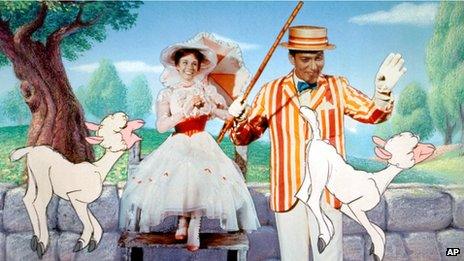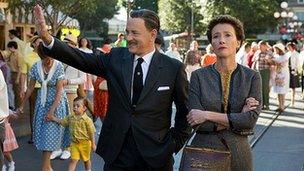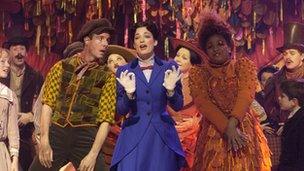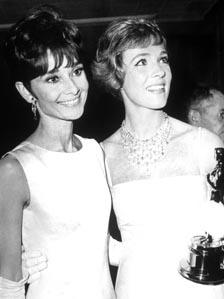Mary Poppins: Brian Sibley's sequel that never was
- Published

It was widely believed that Travers disliked the 1964 film which co-starred American actor Dick Van Dyke
Brian Sibley is one of writing's multi-hyphenates. He is a prolific and award-winning writer of radio drama, such as Radio 4's acclaimed Lord of the Rings adaptations. He has written plays of his own and many books focusing on film. The subjects of his biographies range from CS Lewis to Mickey Mouse.
In fact, a love of Disney has been central since childhood. At home his walls are plastered with Disney artwork.
"In the 1980s, it was exciting to be flown over to LA to sit in script conferences at Disney, working on what looked like a marvellous project - the studio's second Poppins movie."
Though the screenplay he wrote with PL Travers was never made, he looks back on the experience fondly. And he's in a unique position to explain what she really thought about the 1964 film.

The film Saving Mr Banks sees Tom Hanks and Emma Thompson play Disney and Travers
"I first corresponded with Pamela Travers in the 1970s, when I was writing a book about Walt Disney. I didn't get to meet her for a decade but when finally we met it quickly became a friendship.
"Since she died, Pamela's been painted as an old dragon but it's not true: I'd go round for tea on a Sunday and she was great company. Writing with her turned out to be an eccentric experience but that was because she remained proprietorial about Mary Poppins.
"But why shouldn't she be? - it was her creation. Though Pamela, who was very spiritual, would probably have said that the character had been given to her."
Disney approach
The first Poppins film had been a massive hit. "But in some ways it's quite a loose adaptation, " Brian Sibley says. "Her books were really collections of free-standing short stories. The first film used elements both of the original Mary Poppins book (published 1934) and the second one, Mary Poppins Comes Back.
"The Disney studio had been very keen to make a sequel but Pamela always said no. One Sunday we were having tea when she mentioned they'd been in contact. She described the latest idea to me and said she was about to reject it."
"I said it was a pity there couldn't be a new film - so many people had loved the Mary Poppins character. Pamela said 'Oh I could only agree if I could do it on my own terms. I'd have to work with someone I trust.' And she paused. 'If it were you dear that would be different."

The film was adapted for the stage in 2004
"So I wrote a letter to Roy Disney (Walt's nephew, by now in charge) who I had met a few times. This was the 1980s and people still wrote letters. I told him there might be a chance of making the film. After a couple of days I got news Roy was sending someone to London to talk to me. Within a fortnight we were working on an outline."
The project was Mary Poppins Comes Back, based on those parts of Travers' second book unused in 1964. Disney contracted Sibley and Travers to supply a treatment which they then set to work to expand.
"For months I would sit and talk with Pamela at her home in Chelsea about the ideas I had. Then she would give me notes on what Mary Poppins would or would not do and think. She was very particular, even down to how a line should be said. I recorded her on tape and went away. Of course I then wrote what I needed to write - but I always bore her comments in mind. I would give her my script pages and she would write notes all over it. Some parts came back with 'no No NO!' scrawled all over the page. But she also said when she liked what I'd written."
Casting difficulties
Sibley thinks they managed to find a balance between what Travers had written in her books and what the Poppins character then became in the film.
But he also sensed a cloud looming over the movie's chances of getting made - the thorny issue of casting.
"It was more than twenty years since the original so who could play Mary? Julie Andrews was no longer in her twenties and she had moved a long way from the My Fair Lady - Sound of Music stage of her career. Disney made an approach but it came to nothing. And who could ever have played Mary Poppins half as well?"
Casting the world's most famous nanny was not the only quandary. "In our screenplay there was no longer a Bert (as played by Dick van Dyke). Instead there was Bert's brother, who had a similar function of being Mary's friend and possible admirer.

Andrews won best actress at the 1965 Academy Awards
Finding a Bert replacement was almost as tricky as re-casting the lead role.
"I remember sitting in a restaurant on Rodeo Drive listening to an executive explain they thought Michael Jackson might be right for the part. Bear in mind this was an ice-cream seller in a park in Edwardian London. Or maybe it would have worked - who knows?"
And contrary to popular belief, Sibley insists it's untrue that PL Travers hated the original film.
"She may have mellowed in her views by the time I knew her but she knew there were good things in it. When we got down to work I thought it would be a good idea if we watched the original film first so I arranged a private screening.
"I asked Pamela how long it was since she'd seen Poppins - this was the mid-1980s. She said 'Well not since the premiere, obviously'. I was astonished she hadn't seen this hugely famous film for more than twenty years. But Pamela didn't have a video or even a TV set.
"Throughout the film she gave me notes. There were one or two moments where she said 'Oh that's terrible'. But there were more where she got excited at what was up there on screen. She patted my hand and said 'Oh we must remember that, that's excellent, I like that bit very much...' And that's how we began to build our screenplay."
Eventually the sequel fell victim to a combination of inherent casting problems and the fact that new executives were running Disney.
"But I treasured my time working with PL Travers," Sibley says. "And we stayed in touch almost until she died. She was demanding as a friend. But she had great wisdom and great knowledge of so many things: literature, life, love, faith. She was prickly and difficult at times. But she was also someone of a towering intellect whose friendship I really valued."
- Published8 August 2013